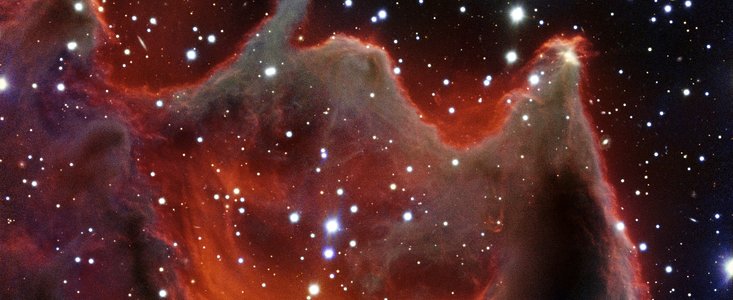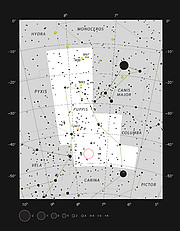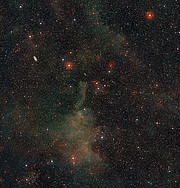Pressmeddelande
Odjurets gap
VLT fångar bilder på kometglobulen CG4
28 januari 2015
Likt gapet hos ett gigantisk himmelskt odjur glöder kometglobulen CG4 hotfullt i den här nya bilden från ESO:s Very Large Telescope. Fastän den ser ut att vara stor och ljus så är detta i verkligheten en ljussvag och för amatörastronomer svårupptäckt nebulosa. Det är också fortfarande ett mysterium exakt vad CG4 är.
Flera avlånga kometliknande objekt upptäcktes 1976 på bilder tagna från Australien med det brittiska UK Schmidt Telescope. På grund av deras utseende kom de att kallas kometglobuler fastän de inte har något gemensamt med kometer. De upptäcktes i ett stort område av lysande gas som kallas Gumnebulosan. De hade täta, mörka, dammiga huvuden och långa, ljussvaga svansar som oftast pekade bort från Supernovaresten Vela som ligger i mitten av Gumnebulosan. Fastän dessa objekt ligger relativt nära till oss så tog det astronomer en lång tid att hitta dem eftersom de lyser bara svagt och därför är svåra att upptäcka.
Objektet i bilden, CG4, även känd som Guds hand, är en av dessa kometglobuler. Den ligger drygt 1300 ljusår från jorden i stjärnbilden Akterskeppet.
Huvudet på CG4, som är den delen som är synlig i den här bilden och som påminner om huvudet hos det gigantiska odjuret, har en diameter på 1,5 ljusår. Globulens svans – som sträcker sig neråt och inte är synlig i bilden – är omkring 8 ljusår lång. Med astronomiska mått mätt är detta ett jämförelsevis litet moln.
Den relativa lilla storleken är ett allmänt drag hos kometglobuler. Alla kometglobuler som hittils upptäckts är isolerade, relativt små moln i Vintergatan bestående av neutral gas och stoft, och som är omgivna av varmt joniserat material.
Huvudet på CG4 är ett tjockt moln av gas och stoft som bara är synligt eftersom det är upplyst av ljuset från närliggande stjärnor. Ljuset som stjärnorna skickar ut förstörs gradvis av globulens huvud och nöter bort de små partiklar som skringrar stjärnljuset. Men CG4:s stoftiga moln innehåller fortfarande gas som räcker för att tillverka flera stjärnor stora som solen. CG4 bildar faktiskt redan aktivt nya stjärnor, troligen utlöst av ljus som når CG4 från stjärnorna som också ligger bakom att Gumnebulosans lyser.
Varför CG4 och andra kometglobuler just sådana former är fortfarande något som diskuteras ivrigt bland astronomer och detta har lett till två teorier som försöker förklara detta. Varje kometglobul, som till exempel CG4, kan ursprungligen ha varit en sfärisk nebulosa och på grund av följdverkningar efter en närliggande supernovaexplosion fått sin nya, ovanliga form. Andra astronomer föreslår att kometglobulen formats av stjärnvindar och joniserad strålning från heta, tunga OB-stjärnor. Dessa effekter kan först leda till bisarra (men lämpligt namngivna!) formationer kallade elefantsnablar och därefter så småningom kometglobuler.
För att lära sig mer behöver astronomer ta reda på massan, tätheten, temperaturen och hastigheten hos materialet i globuler. Man kan bestämma dessa från molekylära spektrallinjer, där de flesta är tillgängliga i millimetervåglängder – våglängder som teleskop såsom Atacama Large Millimeter/submillieter Array (ALMA) kan observera.
Den här bilden kommer från ESO:s Cosmic Gems program, ett populärvetenskapligt initiativ som producerar bilder på intressanta, spännande och vackra objekt med hjälp av ESO-teleskop i utbildnings och populärvetenskapligt syfte. Programmet använder sig av teleskoptid som annars inte kan användas för vetenskapliga observationer. All data som samlas in är också användbart för vetenskapliga syften och är tillgängliga för astronomer genom ESO:s vetenskapliga arkiv.
Noter
Mer information
ESO, Europeiska sydobservatoriet, är Europas främsta samarbetsorgan för astronomisk forskning och världens mest produktiva astronomiska observatorium. Det stöds av 15 länder: Belgien, Brasilien, Danmark, Finland, Frankrike, Italien, Nederländerna, Portugal, Schweiz, Spanien, Storbritannien, Sverige, Tjeckien, Tyskland och Österrike. ESO:s ambitiösa verksamhet rör design, konstruktion och drift av avancerade markbaserade forskningsanläggningar som gör det möjligt för astronomer att göra banbrytande vetenskapliga upptäckter. ESO spelar dessutom en ledande roll i att främja och organisera samarbeten inom astronomisk forskning. ESO driver tre unika observationsplatser i Chile: La Silla, Paranal och Chajnantor. Vid Paranal finns Very Large Telescope, världens mest avancerade observatorium för synligt ljus, och två kartläggningsteleskop: VISTA, som observerar infrarött ljus och är världens största kartläggningsteleskop, samt VST, det största teleskopet som konstruerats för att kartlägga himlavalvet i synligt ljus. ESO bidrar dessutom till ALMA, ett revolutionerande astronomiskt teleskop och världens hittills största astronomiska projekt. ESO planerar för närvarande bygget av det europeiska extremt stora 39-metersteleskopet för synligt och infrarött ljus, E-ELT. Det kommer att bli ”världens största öga mot himlen”.
Länkar
Kontakter
Richard Hook
ESO education and Public Outreach Department
Garching bei München, Germany
Tel: +49 89 3200 6655
Mobil: +49 151 1537 3591
E-post: rhook@eso.org
Johan Warell (Presskontakt för Sverige)
ESO:s nätverk för vetenskaplig kommunikation
Skurup, Sverige
Tel: +46-706-494731
E-post: eson-sweden@eso.org
Om pressmeddelandet
| Pressmeddelande nr: | eso1503sv |
| Namn: | CG4 |
| Typ: | Milky Way : Nebula : Type : Star Formation |
| Facility: | Very Large Telescope |
| Instruments: | FORS1 |
Our use of Cookies
We use cookies that are essential for accessing our websites and using our services. We also use cookies to analyse, measure and improve our websites’ performance, to enable content sharing via social media and to display media content hosted on third-party platforms.
ESO Cookies Policy
The European Organisation for Astronomical Research in the Southern Hemisphere (ESO) is the pre-eminent intergovernmental science and technology organisation in astronomy. It carries out an ambitious programme focused on the design, construction and operation of powerful ground-based observing facilities for astronomy.
This Cookies Policy is intended to provide clarity by outlining the cookies used on the ESO public websites, their functions, the options you have for controlling them, and the ways you can contact us for additional details.
What are cookies?
Cookies are small pieces of data stored on your device by websites you visit. They serve various purposes, such as remembering login credentials and preferences and enhance your browsing experience.
Categories of cookies we use
Essential cookies (always active): These cookies are strictly necessary for the proper functioning of our website. Without these cookies, the website cannot operate correctly, and certain services, such as logging in or accessing secure areas, may not be available; because they are essential for the website’s operation, they cannot be disabled.
Functional Cookies: These cookies enhance your browsing experience by enabling additional features and personalization, such as remembering your preferences and settings. While not strictly necessary for the website to function, they improve usability and convenience; these cookies are only placed if you provide your consent.
Analytics cookies: These cookies collect information about how visitors interact with our website, such as which pages are visited most often and how users navigate the site. This data helps us improve website performance, optimize content, and enhance the user experience; these cookies are only placed if you provide your consent. We use the following analytics cookies.
Matomo Cookies:
This website uses Matomo (formerly Piwik), an open source software which enables the statistical analysis of website visits. Matomo uses cookies (text files) which are saved on your computer and which allow us to analyze how you use our website. The website user information generated by the cookies will only be saved on the servers of our IT Department. We use this information to analyze www.eso.org visits and to prepare reports on website activities. These data will not be disclosed to third parties.
On behalf of ESO, Matomo will use this information for the purpose of evaluating your use of the website, compiling reports on website activity and providing other services relating to website activity and internet usage.
Matomo cookies settings:
Additional Third-party cookies on ESO websites: some of our pages display content from external providers, e.g. YouTube.
Such third-party services are outside of ESO control and may, at any time, change their terms of service, use of cookies, etc.
YouTube: Some videos on the ESO website are embedded from ESO’s official YouTube channel. We have enabled YouTube’s privacy-enhanced mode, meaning that no cookies are set unless the user actively clicks on the video to play it. Additionally, in this mode, YouTube does not store any personally identifiable cookie data for embedded video playbacks. For more details, please refer to YouTube’s embedding videos information page.
Cookies can also be classified based on the following elements.
Regarding the domain, there are:
- First-party cookies, set by the website you are currently visiting. They are stored by the same domain that you are browsing and are used to enhance your experience on that site;
- Third-party cookies, set by a domain other than the one you are currently visiting.
As for their duration, cookies can be:
- Browser-session cookies, which are deleted when the user closes the browser;
- Stored cookies, which stay on the user's device for a predetermined period of time.
How to manage cookies
Cookie settings: You can modify your cookie choices for the ESO webpages at any time by clicking on the link Cookie settings at the bottom of any page.
In your browser: If you wish to delete cookies or instruct your browser to delete or block cookies by default, please visit the help pages of your browser:
Please be aware that if you delete or decline cookies, certain functionalities of our website may be not be available and your browsing experience may be affected.
You can set most browsers to prevent any cookies being placed on your device, but you may then have to manually adjust some preferences every time you visit a site/page. And some services and functionalities may not work properly at all (e.g. profile logging-in, shop check out).
Updates to the ESO Cookies Policy
The ESO Cookies Policy may be subject to future updates, which will be made available on this page.
Additional information
For any queries related to cookies, please contact: pdprATesoDOTorg.
As ESO public webpages are managed by our Department of Communication, your questions will be dealt with the support of the said Department.





